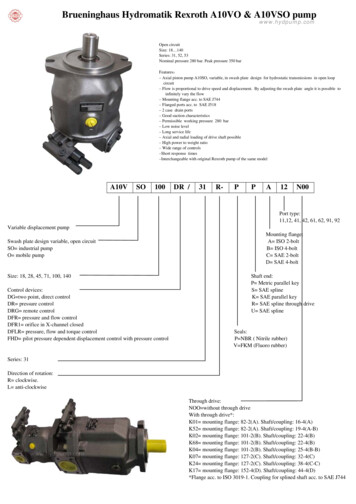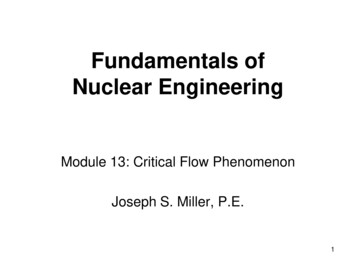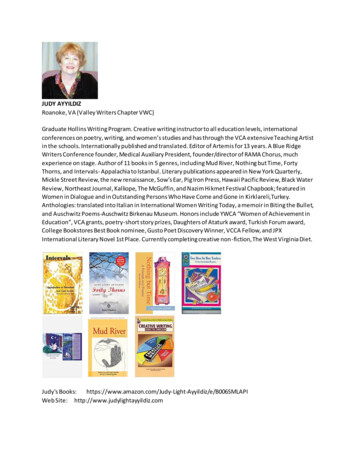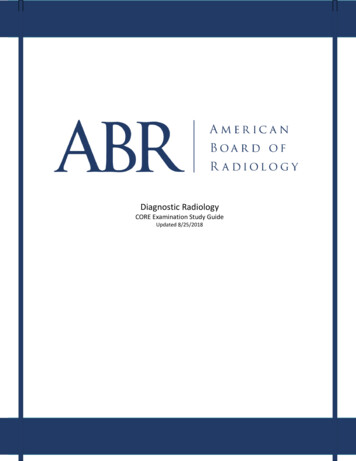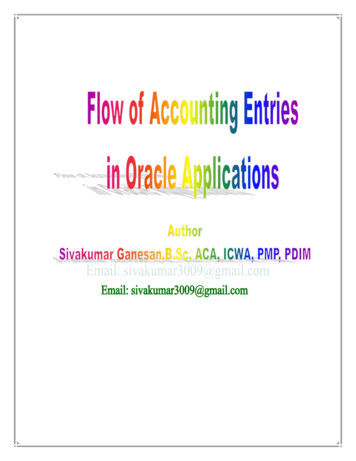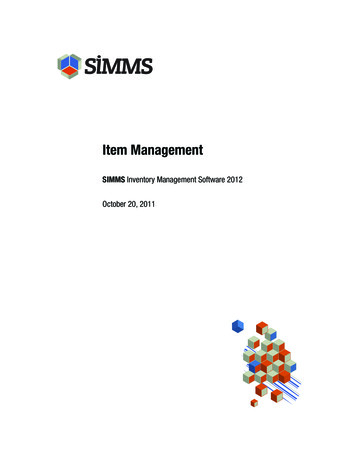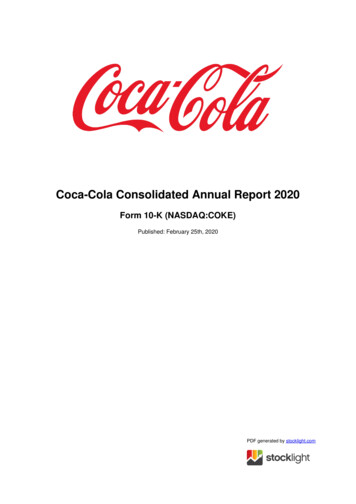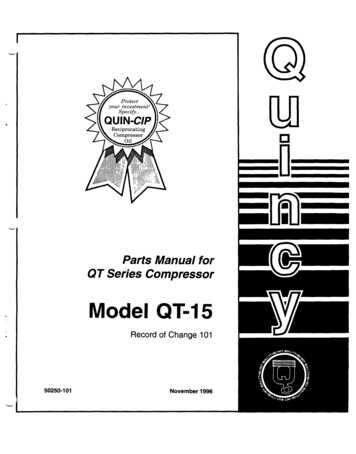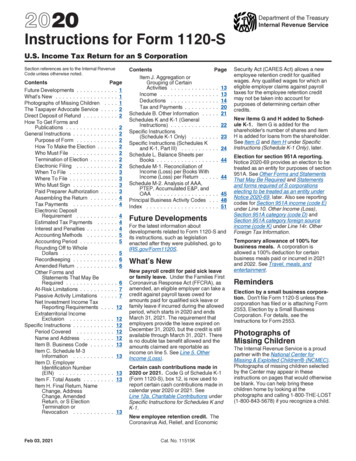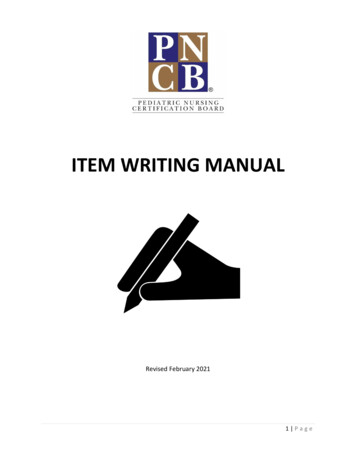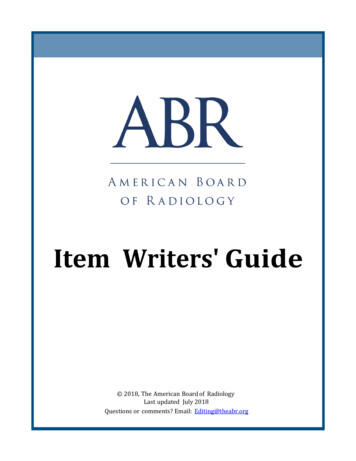
Transcription
Item Writers' Guide 2018, The American Board of RadiologyLast updated July 2018Questions or comments? Email: Editing@theabr.org
TABLE OF CONTENTSForeword . 1Getting ready . 1Write the stem . 5Write the key (the correct answer). 9Write the distractors . 9Review the item. 15Appendix A: Item-Writing Basics . 16Appendix B: Ideas to Help You Get Started*. 17Appendix C: Advanced Item Types . 19Appendix D: Common Item Edits for ABR Style. 23Appendix E: Editing Example . 24
ForewordThank you for volunteering to write items for the American Board of Radiology (ABR)examinations. We appreciate the gift of your time and expertise.This guide provides general instructions for choosing content and formatting items for ABR exams.Most of the rules and examples pertain to standard multiple-choice questions with a single bestanswer. ABR exams also include R-type and drag-and-drop (point-and-click) items and may includefill-in-the-blank and multiple-correct-option items. These types of items follow many of the sameprinciples as standard multiple-choice questions; the differences in format are explained inAppendix C: Advanced Item Types.This guide is designed for reference as you write. Points of item writing are explained in detail inthe body of the manual. As you get comfortable with the process, you may find that all you need is achecklist to guide you from start to finish, such as that provided in Appendix A: Item-Writing Basics.Getting readyStart earlyOne part of successful writing is the review. To be as objective as possible, you should give yourselfseveral days between writing and assessing items before submitting them. This allows you to clearyour mind of the process, “forget” what you wrote, and look at the items with fresh eyes. Waitinguntil just before the deadline to do your writing robs you of this important perspective.Consider your audienceIt is important to consider the candidates as you write. If what we present is not relevant to theirexperience or to their expected field of work, the item does not serve its purpose. For InitialCertification examinations, items should deal with subjects that are taught in most residencyprograms. For Maintenance of Certification exams, items should be practice oriented.Item formatEach item on an ABR exam focuses on one concept to be tested. For each standard multiple-choicequestion, there is one best answer among the choices, and to the prepared candidate it is clearlythe right answer. Our objectives are to: test knowledge of the subject matter presented; test one piece of information per item; create items that are clear and concise, so the candidate can answer as many as possibleduring the time allotted.1
Decide on your topic Is it relevant?One thing that makes even a well-written item unusable for testing is if it asks forinformation that has little to do with the practice of radiology or with case management ingeneral. Remember that we are testing the candidate’s ability to practice radiology safelyand effectively. Items should not only be relevant, but also be important to practice. Is it something the candidate must know to be successful in practice?Candidates must clearly understand certain basic concepts. In addition, perception,interpretation, and deduction skills should be developed in training. All of these skillsshould be tested. Is it based on controversial opinions, studies, or material?Items that relate to specific studies, regional practices, or the methods of particular doctorsshould not be used. Likewise, items should not focus on trendy subjects (those that maychange in a short period of time) or on practices and theories that are open to debate.Choose and cite your reference(s)Decide what sources you will be using. We require at least one complete reference for every item.References need to be credible sources that are widely studied, replicated, and verified. Theyshould not be specialized or controversial. Among other things, references are our defense if anitem is challenged. Be sure the reference supports the correct answer. At this time, somepreapproved websites are acceptable as references. Check with your committee chair.Decide what single task you want the candidate to performAn effective item points toward a single option; therefore, the stem should be focused in onedirection, making the path to the answer clear. The item should ask the candidate to complete onetask and answer one question.Recall informationSome information should be memorized and easy for a radiologist to bring to mind. Thefollowing is an example of a recall item:What is the most common cause of superior vena cava syndrome?A.B.C.D.TuberculosisMalignancy [key]PericarditisMediastinal fibrosis2
Apply knowledgeThe candidate must be able to apply knowledge in specific situations. This type of itembuilds on recall skills but requires more of the candidate, such as abstracting meaning fromdata, recognizing implications of clinical findings, identifying abnormalities on radiographs,or comparing possible treatment approaches. The following is an example of an interpretiveitem:A guidewire-induced spasm of the popliteal artery occurs during angioplasty of thesuperficial femoral artery. What is the most appropriate intra-arterial medication olazolineNitroglycerin [key]Solve a problem (not necessarily through mathematical calculation)Here we are testing whether the candidate can make judgments and decisions to deduceanswers to complex clinical questions or to select a strategy. The following are examples ofproblem-solving items:An image of the brain is obtained using a spin-echo MRI pulse sequence with TR 1000 msand TE 100 ms. What anatomical structure has the highest signal intensity?A.B.C.D.White matterLens of the eyeCerebrospinal fluid [key]Intracranial fatImmediately after balloon angioplasty of an atherosclerotic stenosis of the superficialfemoral artery, angiography shows acute closure of the vessel. What is the most likelycause?A.B.C.D.E.SpasmThrombosisDissection [key]RuptureRecoilOther tasks the candidate may performOther items may evaluate a candidate’s interpretive and problem-solving skills by askinghim or her to do the following:o Interpret diagnostic images, data, graphs, or tableso Use pathophysiology to predict findings from certain conditions3
oooooooExplain why something has occurredOrder diagnostic studiesDetermine the cause of a condition or findingDesign an overall treatment program (including surgery, radiation therapy, andchemotherapy) or quality management programSelect or optimize a treatment planCalculate a tumor doseDetermine a prognosisDesign the item so there is only one question to be answeredWe recommend that standard multiple-choice items ask for only one answer. Because we do notoffer partial credit, items that have multiple-part options do not discriminate as well as those with asingle answer. In addition, overlapping options can provide clues for savvy test-takers to guess thecorrect answer by looking at which parts occur most frequently.Incorrect:A 47-year-old woman has mammography, and unilateral axillary adenopathy is detected. She hasno known inflammatory or infectious cause. What is the most appropriate BI-RADS assessment andrecommended next step?A.B.C.D.Category 1: Negative; return to screeningCategory 2: Benign; return to screeningCategory 3: Probably Benign; follow-up mammography in 6 monthsCategory 4: Suspicious; biopsy [key]Fix this by splitting the questions into two separate items.Correct:A 47-year-old woman has mammography, and unilateral axillary adenopathy is detected. She hasno known inflammatory or infectious cause. What is the most appropriate BI-RADS assessment?A.B.C.D.Category 1: NegativeCategory 2: BenignCategory 3: Probably BenignCategory 4: Suspicious [key]-andA 47-year-old woman has mammography, and unilateral axillary adenopathy is detected. She has noknown inflammatory or infectious cause. What is the most appropriate next step?A.B.C.D.Return to screeningUltrasound of the breastFollow-up mammography in 6 monthsTissue biopsy [key]4
Decide what level of knowledge you want to testConsider the following:What city is the capital of Arizona?A. AlbuquerqueB. DallasC. PhoenixD. SacramentoA person is not required to have knowledge about Western cities to choose the right answer.However, what if the item is written this way?What city is the capital of Arizona?A. TucsonB. FlagstaffC. PhoenixD. YumaTo answer this question, a person must know much more about Arizona cities to make the correctchoice. Think about where the stem is going to lead the candidate in his or her “personal database.”What level of knowledge do you want to test?Write the stemThe stem is the part of the item that asks for a response. Stems should be written as completesentences that end with a question. The stem should present all the information necessary for thecandidate to figure out the answer without having to look for clues in the option list.Stay focusedSuppose a stem is written like this:In breast MRI, the chemical shift artifact:orWhich of the following statements about chemical shift artifact is true?What is being asked about artifacts? Any number of ideas could run through the candidate’smind. The intent is not clear. These stems fail the “cover test.” To pass the cover test, an5
item must be answerable with the option list covered. In other words, the examinee shouldbe able to predict the type of answer being sought before looking at the options.Avoid using “Which of the following is true?” construction. Although used in the past,this type of stem is unfocused and usually leads to mixed options. Rewrite the item so it asksa single, focused question that passes the cover test. Often, more than one focused item canbe generated from an item with this construction.This stem is improved from the previous example:What MRI parameter could be changed to reduce chemical shift artifact?Now the candidate understands what we are asking. If he or she knows the answer, it’s justa matter of finding it in the options.Be aware of sentence structure and linearityThe most effective way to deliver information is in a linear fashion—one that allows themind to follow a path, arriving smoothly at the point that an answer must be given. Focusingthe stem in this way will also help you focus the options.The formula most suited to linear thought is:Background info Situational info (or equation) Request for solutionFor example,A 7-year-old girl presents with a mild fever and swollen lymph nodes. Three days later,she develops a rash that starts on the face and spreads to the neck, chest, and the rest ofthe body. What is the most likely diagnosis?It is important that the question is asked at the end of the stem, after all the informationneeded to answer the question has been provided. In this example of nonlinear structure,the question comes at the beginning:What percentage of patients will survive at least 42 months if they are part of a groupthat exhibits lifetimes that are normally distributed with a mean of 36 months and astandard deviation of 3.0 months?In this instance, the candidate would already be trying to formulate an answer (orwondering how it can be done) before crucial information is given.6
A better, linear way to present the information is:A group of patients exhibits lifetimes that are normally distributed with a mean of 36months and a standard deviation of 3.0 months. What percentage of these patients willsurvive at least 42 months?Use common and precise languageWe are not testing vocabulary. Try not to use specialized words when common words willbe sufficient. Common words are more effective because they ensure that candidates arenot laboring to understand the item, and that we are in fact testing knowledge of the subjectmatter—not language skills.Likewise, language needs to be medically, scientifically, and technically precise, accurate,and consistent. This may mean refraining from “this is just how we say it” type thinking toincrease clarity, reduce ambiguity, and use nomenclature consistently. This is equallyimportant for the medical field in general and for the examinations leading to boardcertification.Be clear and conciseCandidates have a limited amount of time to answer questions. Therefore, stems should beclear and concise. Long, involved explanations or histories should be avoided. State only theinformation needed to answer the question. The following stem is overly detailed:A 60-year-old woman presents with rectal bleeding and is found to have anadenocarcinoma of the midsigmoid colon. It is completely resected by low anteriorresection, and five out of five lymph nodes are negative. No adjuvant therapy is given.Two years later, she presents with anorexia and a 10-pound weight loss and is found tohave liver metastases. What is the most appropriate treatment now?This stem could be rewritten more simply as:A 60-year-old woman presents with an adenocarcinoma of the midsigmoid colon. It iscompletely resected. Two years later, she develops liver metastases. What is the mostappropriate treatment?We don’t want to waste the candidate’s time with extraneous reading. A stem that rambles,delivers information disconnectedly, or includes too much information not directly relatedto the question being asked can be confusing and can draw the candidate away from thetask at hand. Although it might be appropriate to include some extraneous information in astem to test whether the candidate can glean the pertinent points, it is important that thestem maintain a high degree of focus.7
Avoid negativesWe are trying to ascertain what the candidate knows, not how easily a test-taker can beconfused. It is best to avoid items that require reverse thinking. It complicates thepresentation of information. A negative stem presents the following problem:Background info Situational info (or equation) Request for solution, but—oh, by theway—give us the opposite of what we’ve led you to think about.Avoid writing items that include:o Which of the following is FALSE?o Which of these is NOT an indicator . . . ?o All of the following are true EXCEPT:o What is the LEAST likely . . . ?This kind of item is easy to write because it only requires three or four facts from referencesand one fabricated “fact.” But asking for a false “answer” is more a test of the candidate’sability to think in reverse than knowledge of the subject. Often, even experts will read thistype of stem and mentally proceed to the CORRECT answer. Test-takers tend to choose thefirst correct answer in the list and often don’t remember that they were supposed to beseeking the INCORRECT option.Negative wording is appropriate for two types of items:o those that ask what should be excluded from a differential diagnosis;o those that ask about a practice to be avoided because of the potential for seriousside effects.If a stem must contain a negative term, it should appear in capital letters and boldface type.Avoid second personThe exam should be testing a candidate’s understanding of facts, not asking for theiropinions. Write in third person rather than second. Second-person construction issubjective. For example, instead of writing “How would you interpret this image?” write“What is the best interpretation of the image?”8
Write the key (the correct answer)It should offer the most plausible response.To the prepared candidate, there should be no doubt that the key is the only option that couldpossibly be selected from the list of choices. The prepared candidate will readily choose it.It should make sense grammatically.Whether the key answers a question with a phrase or a full sentence, it should be in propersyntax.It should be similar in length to the distractors.Nothing gives away the right answer faster than having one choice that is well thought outand carefully worded and distractors that are choppy, too short, too long, etc. Candidates canalso be drawn to distractors that are different from the others. To ensure that options arechosen because they are the best answers, and not because of a clue, try to make them assimilar to the distractors as possible.Write the distractorsDistractors are the other possible answers in the option list. Distractors are perhaps the hardestpart of the item to write because they must, on some level, seem like reasonable options.They should be plausible.To the unprepared or underprepared candidate, distractors should seem like they couldpotentially be the right answers. Additionally, the distractors need to be real things. Pleasedo not invent terms to complete the option list.There may be two to four distractors (three to five total options).It is better to have fewer plausible distractors than a list of options with more distractorsthat are obviously incorrect. A distractor that adds nothing (or doesn’t fit the list) cannegatively skew the statistics for that item.Three total options can be used, especially when a fourth plausible option is difficult orimpossible to provide (e.g., when the question asks the candidate to determine whether adose or agent increases, decreases, or remains the same under specific circumstances).9
They should all be in the same category.Be sure distractors are rooted in the same material as the correct answer.Which of the following is associated with osteoarthritis?A.B.C.D.Patient age 50 years [demographic information]Radiography is preferred to MRI. [key] [imaging]Nutritional deficiency [presentation]Family history is not a risk factor. [negative risk factor]Mixed options are a common problem in items that have unfocused stems. If you findyourself writing mixed options, go back and look at the structure of your stem. A focusedstem would ask a direct question like “What is the most appropriate initial imagingmodality?” [key Radiography]They should be similar in length to the key.As with the key, you shouldn’t have one distractor that is well thought out and carefullyworded, while the others are choppy, too short, too long, more specific, use qualifyingphrases, etc. Try to make all options as similar as possible.Why is Lipowitz metal (Cerrobend) more appropriate than lead for custom blocking?A.B.C.D.It is much easier to machine than lead.It has a much lower melting point than lead. [key]It is composed primarily of cadmium, a less toxic substance than lead.Custom blocks made of Lipowitz metal (Cerrobend) have a sharper penumbra thancustom blocks made of lead.E. Its linear attenuation coefficient is higher than that of lead.Option D is longer and worded differently from the others. In this case it is not the key, butits differences could cause candidates to think it is the correct answer. What if it is changedto read as follows?D. It forms blocks that have a sharper penumbra than custom lead blocks.Now it more closely matches the other options. Therefore, if it is chosen, it will be becausethe candidate thinks it is the right answer, not because of a trick. If a distractor cannot berewritten to have a similar length and structure to the other options, the best solution maybe to eliminate it from the list.They should be the same part of speech as the key.An option that is a different part of speech from the other options sticks out, especially if itdoesn’t make sense grammatically as an answer to the question.10
They should not create “tricks.”As illustrated above, the way options are worded may “trick” the candidate into selecting anincorrect answer. We are not trying to trick the candidate with language or vague clues. Onthe contrary, we are trying to make it possible for each candidate to answer as many itemsas possible in the allotted time, thereby affording the greatest chance of success.oNegativesHaving an option in the negative is more a test of reverse thinking than ofknowledge. The following item, in addition to having an unfocused stem and mixedoptions, is further weakened by tricky negative language:Which of the following statements most accurately describes Turner syndrome?A.B.C.D.E.A webbed neck is not found frequently.The ovaries usually have normal function.Patients typically do not have two complete X chromosomes. [key]The cause for short stature is clearly understood.Patients rarely have shield-like chests.Option A contains a negative term (“not”), which a candidate could easily miss.Options A, B, and E are examples of reverse truths, two of which are fairly obvious.(A reverse truth is a true statement that is made false simply by changing orinserting a word or two.) Option D is improbable, using the word “clearly.” The keyalso contains a negative term, forcing the candidate to think in the reverse.oJargon, slang, acronyms, etc.Other tricks that can be confusing to the candidate include use of jargon, slang,acronyms, and abbreviations.A 74-year-old man is admitted for evaluation of a T4N2b squamous cell cancer ofthe hypopharynx. The patient has cardiac arrest and a code is called. What is themost appropriate next step?A.B.C.D.Bolusing with “roids”TubingBaggingScopingThe issue of fairness arises in this situation because not all candidates may befamiliar with these particular terms. Standard medical terminology should be usedin all examination items for clarity and fairness.11
This also applies to acronyms. With few exceptions, ABR policy is to spell out termson first use in an item, with the acronym following in parentheses. The acronym canthen stand alone in the remainder of the item. This is to avoid confusion of termsand to make information absolutely clear.They should not contain “clues.”Some candidates have mastered the art of test-taking, including how to figure out whatchoices are not correct by looking for clues. “Clues” include language or constructions thatmay help unknowledgeable but test-wise candidates select the correct option. Somegiveaways are as follows:oVague and absolute termsVague terms—might, may, can—are clues to the key because they indicate thatalmost anything is within the realm of possibility. Absolute terms—always, never—are clues to distractors because there are no exceptions.The following item illustrates both points:Which of the following is a characteristic of Ewing sarcoma?A.B.C.D.E.It always involves the diaphysis.It involves the metaphysis more commonly than the diaphysis.It may involve the epiphysis. [key]Extraosseous Ewing sarcoma has never been reported.It almost always involves long tubular bones.Notice that the stem is unfocused and that the options are mixed. In addition, for theobservant candidate, Options A, D, and E can be eliminated from consideration inthis item because the terms “always” and “never” mean there are no exceptions. Onthe other hand, Option C is almost certain to be the correct response because theterm “may” includes all possibilities.To improve this item, focus the stem, remove the clues, and make the optionshomologous:Which of the following is usually involved in Ewing sarcoma?A. DiaphysisB. MetaphysisC. Epiphysis [key]12
Now the stem asks a clearer question. Although “usually” is vague, moving it to thestem makes it equally applied to all options. The answers are straightforward. Thereis no ambiguity, and there are no clues.oDouble/multiple optionsDouble or multiple options are responses that contain two or more pieces ofinformation. As explained under “Design the item so that there is only one questionto be answered,” these options can present scoring issues. Also, many test-takersunderstand the thought process of the writer and can figure out the correct answerbased on the frequency with which each part of the option occurs in the list. Forexample, what if the elements of the options appear as follows?A.B.C.D.1&21&31&42&5The savvy examinee will note that 1 appears 3 times, and 2 appears twice.Therefore, the most likely answer is the one that contains both 1 and 2 (A). It isbetter to stick with one-element answers whenever possible.oAll of the aboveWe do not use this construction.This type of option is typically not a good measurement tool. If candidates recognizetwo correct choices, they know the rest of the list probably follows suit and may noteven read the other choices. These may seem easy to write—just pull a few factsfrom the references—unfortunately, candidates know the technique.oNone of the aboveThe ABR does not use any items in this format.There is an argument that “none of the above” responses can be effective.Sometimes there is no definitive answer to the question, and the item is trying todetermine that the candidate realizes this. A “none of the above” item may actuallyentice the candidate to study all of the options more thoroughly. However, we feelthat the possible negative effects are more relevant to our situation.oPairsPairs occur when two options are very similar to each other but different from therest of the list. A candidate will tend to consider only the two options in the pair andignore the others. For example:13
After a patient has a liver transplant, occlusion of the hepatic artery can causestrictures in what area?A.B.C.D.Portal vein anastomosisHepatic vein anastomosisTransplant bile ducts [key]Lymphatic drainageCandidates will tend to focus on options A and B and figure that one of them iscorrect. If the key is part of the pair, this is a clue to the correct answer. If the key isnot part of the pair, it is a trick.Option lists should either contain no pairs or two (or three) sets of pairs, so that alloptions must be considered. For example:A patient requires a long-term, continuous infusion of medication for pulmonaryhypertension. Which of the following venous access devices would be mostappropriate?A. Implanted port in the chest wall with the catheter inserted via the internaljugular veinB. Implanted port in the upper arm with the catheter inserted via the basilic veinC. Hickman catheter tunneled from the chest wall to the insertion site in theinternal jugular vein [key]D. Quinton catheter tunneled from the chest wall to the insertion site in the internaljugular veinNow candidates must look at both sets of pairs. There is no clue, and the odds ofguessing are returned to 25%.14
Review the itemAs previously mentioned, it is best to write items well before the deadline, then set them aside for awhile. When writers try to revise their own work right away, they tend to miss areas that actuallyneed correction or clarification; the writer may assume the intended meaning rather thanrecognizing any errors in the meaning of the actual words. Returning to items later decreases thisrisk. When you do review the items, consider the following points:Cover the options and see if you can answer the questionThe stem should give sufficient information for the candidate to formulate an answerwithout having to look at the option list for clues (the “cover test”).Look at the stem structureBe sure you are delivering the information in the most direct way possible. Be sure thepresentation is focused, concise, and linear. Also check to be sure the stem is a completequestion, and that it does not contain negative phrasing, if possible.Check the keyWill the prepared candidate recognize that it is clearly the right answer?Is it in the same category and similar in concept, structure, and length as the distractors?Does it properly complete the stem?Consider the validity of the distractorsDo any of them sound ridiculous?Are they all real entities?Are they in the same category and similar to the key in concept, structure, and length?Do they complete the stem appropriately?Do they avoid tricks, clues, and convoluted presentation?Check your reference citationEach item must have at least one complete reference.15
Appendix A: Item-Writing BasicsGeneral State the needed information as concisely as possible and at a comfortable language level.Focus the stem and options; avoid clues and tricks.Make sure the items pass the cover test.Ensure all items are clinically relevant, noncontroversial, and up-to-date.Add the references.Include any necessary images. (It is also permissible to include tables, graphs, or diagrams.)Stems Focus on one concept. To focus an item, think of what the question is asking the candidateto do (e.g., recall information, apply knowledge, solve a problem).Present all the information necessary for
the body of the manual. As you get comfortable with the process, you may find that all you need is a checklist to guide you from start to finish, such as that provided in Appendix A: Item-Writing Basics. Getting ready Start early One part of successful writing is the review.
